TBs at the heart of a transition: From a coastal to a blue water navy – Until the Hochseetorpedoboats (see the earlier article) which were destroyer in all but name, German Torpedo-boats had the responsibility of defending territorial waters of Germany. They were of limited size and therefore of limited value in the rough seas of the North, notably beyond the Dogger Bank. However they were much more at ease in the Baltic.
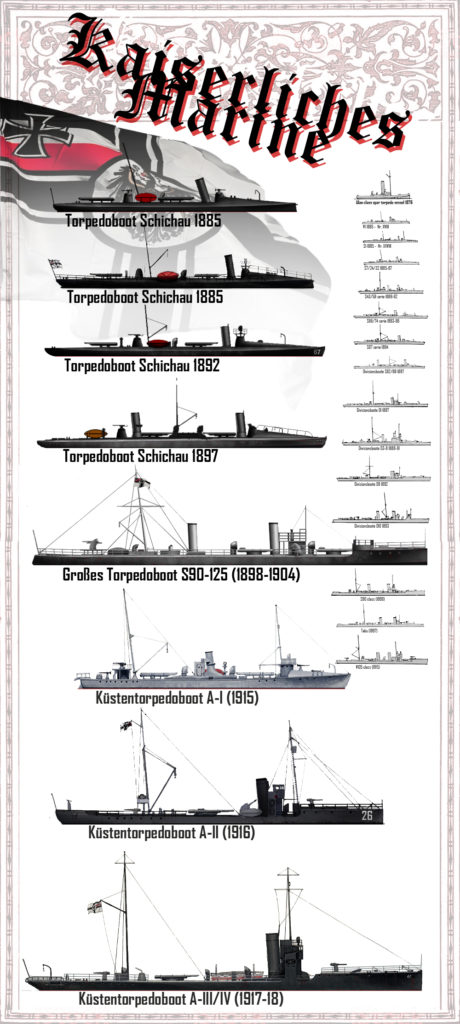
Author’s montage of main Torpedo Boat classes, and appareance of all classes 1883-1918
An introduction
It was in the field of torpedo warfare that the young German Navy showed the most originality as well as the light cruiser. It is for this reason that the Zieten and her successors, though fundamentally torpedo vessels, have been listed under cruisers. At the time the Zieten was ordered experiments had already been made with small launches and bigger tug-type vessels
using spar torpedoes.
Later a few boats armed with ‘fish’ torpedoes were built, but it was not until1884 that Germany started building up a large force of torpedo boats. Orders were placed with a number of German builders, and two boats were purchased from the best British builders for comparison. The result of this sensible procedure was to establish the primacy of the firm of Schichau who then built nearly all the subsequent classes of German torpedo boats.
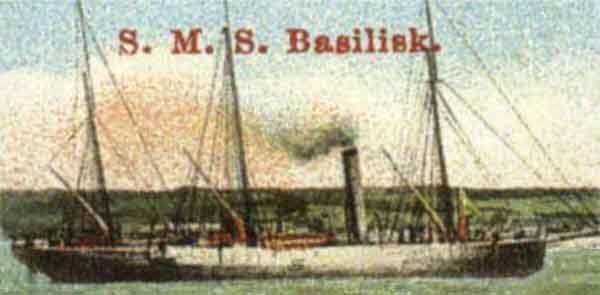
SMS Basilisk (1862). This Prussian Navy gunboat was armed with a single 381 mm torpedo tube.
They also successfully exported their boats and designs to many foreign navies. Schichau‘s foreign sales were Germany’s one export success with warships in this period, but a very noteworthy one. The typical Schichau boat had a distinctive, almost pear-shaped hull, with its greatest breadth well aft, and two funnels side by side well forward.
The German Navy very sensibly insisted on sturdiness and seaworthiness as being more important than a high trial speed in their boats, and equally sensibly built rather larger versions of each class as leaders for each flotilla (Division Boats or ‘D’ boats). Though in a way a prefiguration of the torpedo boat destroyer their basic purpose was different; they were scaled-up torpedo boat designs, it is true, but their extra size was for carrying the extra complement of a flotilla leader, and for extra seaworthiness, not to carry the heavier gun armament to deal with their smaller sisters.
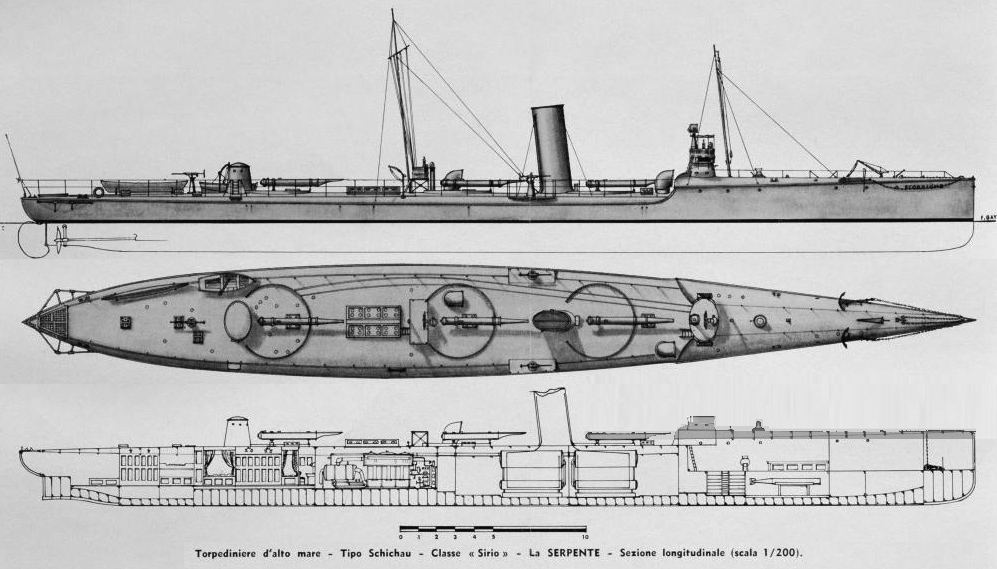
A typical Schichau design for the Regia Marina – The pear-shaped section as seen for aboove is obvious.
They were also considerably slower than the first British destroyers, so it was a sensible move to order a modified version of one of these (D10) to investigate the new type. Afterwards Germany continued to pursue her own course by continuing to give more importance than other navies to torpedoes than to guns in her designs, which, though similar to foreign destroyers, she continued to class as ‘large torpedo boats’.
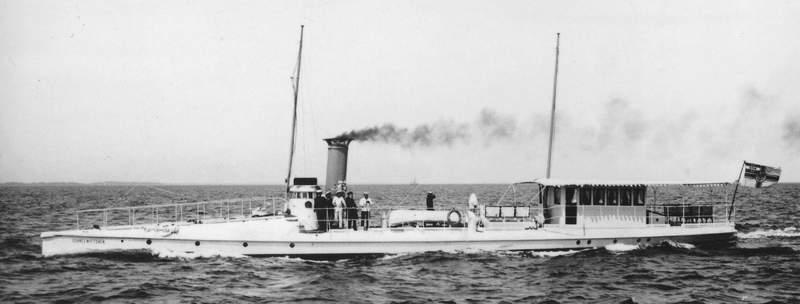
SMS Schneewitchen – Launched on December 20, 1888 at the Gdańsk Imperial Shipyard. She was a former small steel-built torpedo boat (34.61 m long and 4.14 m wide, 2.15 m draft, 72 tons standard). She was armed by two 35 cm torpedo tubes and 37 mm Hotchkiss cannons. Soon technically outdated, disarmed in 1898, she was converted into a station yacht (photo). On January 30, 1899, “Snow White” served at the naval station of the Baltic Sea in Kiel and servived well into the late 1920s.
Another peculiarly German feature was the short raised trawler-type forecastle, which was adopted in her first destroyers and as part of the search for seaworthiness which continued to be a distinctive feature of German ships of this type until after 1914. Because of the continuing emphasis on the primacy of torpedo attack, German vessels remained lower in silhouette, and less
well armed with guns than their British contemporaries.
The First World War was to prove that the heavier guns of British destroyers were, paradoxically, the better answer for successful torpedo attacks, as British destroyers were more successful in breaking through escort screens of their own type of ship than their German equivalents. However the German torpedo craft were excellent, seaworthy designs, and not to be despised as fighting ships.
Although examples of foreign designs were purchased, Germany did not otherwise build any second class torpedo boats designed to be carried and launched by larger ships. Instead she concentrated on the more sensible course of adapting ordinary ships’ boats to carry torpedoes when necessary.
Early origins
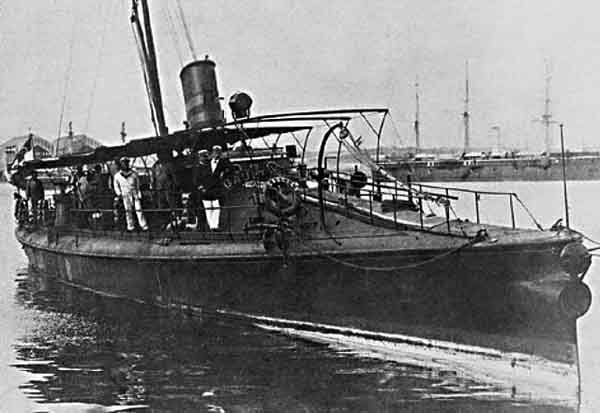
A Schichau 1880s Torpedo Boat
Called Torpedoboote, similar to the British word, their lineage can be traced back to the invention of the torpedo and even before, with spar-torpedo vessels of the Prussian Navy, such as the semi-experimental boats of Devrient, Waltjen, Vulcan and Holberg series in 1871-75. So pretty much right after the unification of Germany, as the result of the Franco-Prussian war of 1870, proclaimed on 18 January 1871, in the Hall of Mirrors at the Palace of Versailles in France, and very much the work of crafty and ambitious Chancellor Otto Von Bismarck.
Of course the collection of small kingdoms and principalities of that time had no proper maritime traditions, nor a maritime area but Prussia. The German Navy was gradually built-up from a minor Prussian fleet, and in 1864, almost built from scratch, this small force participated in the battle of Heligoland between the Danish and Austrian fleets, playing a small part. But on the background, the new German Empire was fast becoming the industrial powerhouse of continental Europe.
In this context it was made clear by Bismarck that the Imperial Navy built on the shoulders of the tiny Prussian fleet, should at least rival its neighbours from Sweden, Denmark, or even Holland under ten years. This was achieved gradually at the end of the 1880s, but the ascendency on the Throne of a young, ambitious and Navy-nerd Kaiser Wilhelm impulsed a vigorous energy to the Imperial Navy, now on the path to rival the great naval powers of the time, France, Russia, and soon, the mighty Royal Navy. Light torpedo vessels were still favoured as a coastal backup defense, at least until the submarine was developed.
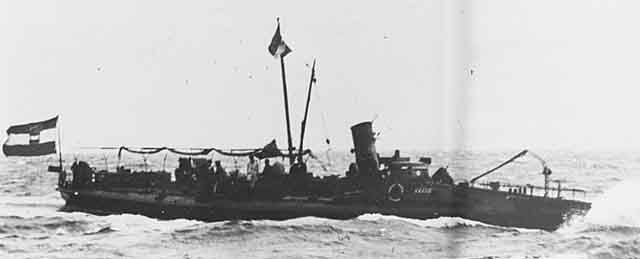
Austro-Hungarian Schichau boat N°38
Development of German torpedo boats
From 6 vessels in 1875, 28 in 1885, the Kaiserliches Marine numbers of torpedo-launching vessels rose to 77 in 1890, 99 five years later and 124 in 1905. There was a clear slowdown as their high seas equivalents had clear preference to be part of a more prestigious Hochseeflotte. From 1905, the torpedo service would also be in competition with the new and promising U-Boats, the first of these, U-1 was just being completed.
In fact, the Hochseeflotte listed no TB, only destroyers, the “Hochseetorpedoboote”. The name reflected the fact, this was just considered as a continuation of the first class torpedo boats, later “Division boats”: Indeed, the latter were very much seen as transitional vessels, in size, armament and displacement quite close to the first generation of “destroyers”, the Thornycroft, Schichau and Germaniawerft boats of 1896 to 1904. In 1914 however they were seen as “second class” and assimilated to torpedo boats.
Indeed the first German Naval Law of 1898 legislated construction of an ocean-going battle fleet, accompanied by flotillas of larger and seaworthy torpedo boats, soon called Grosse Torpedo Boats, and later generally “High seas torpedo boats”. Initially they were given numbers but were ultimately separated in 1911. In 1906 already, former D-class and S-classes of early destroyers were reclassified as torpedo boats.
The 1912 naval law stated that 108 boats were required, in three flotillas, and with three flotilla leaders, alongside 54 submarines, with a material reserve of 36 TBs and 18 submarines and a single flotilla leader.
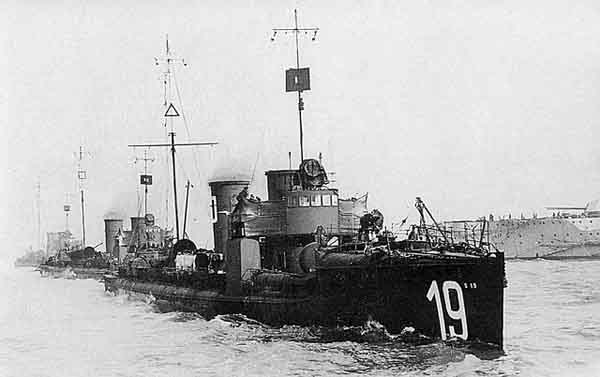
1912 program VII Flotilla Hochseetorpedoboote S19, a development of 1900-1904 Grosse Torpedoboote vessels
Enlisted TBs in 1914
Torpedo boats in German service failed to be stay numerous in service (compared to France in 1900 for example). Dating between 1886 and 1898 and built by Schichau in immense majority (T11-T65 ex-“S” and T66-89) they preceded the “Gross Torpedboote” themselves, precursors of the fleet Hochseetorpedoboote.
They were led by “division boats”, German’s flotlla leaders, sort of large coastal torpedo boat. These were the D1-9 also built by Schichau between 1886 and 1894. (Second class for the T11-65, first for the T66-89). Note that Schichau had also built 4 “destroyers” for China in 1898, one of which was returned to the German Empire after a capture in 1900 during the Allied operation against the Taku forts (See the note about S90).

S125, of the S90 class, in Kiel
The new series started with SMS V1, while older vessels were given a ‘T-‘prefix. A grand total of 336 torpedo vessels were ordered for the German navy, all combined. This was more than the S-Boote of WW2, but torpedo boats as such were only a fraction of these numbers, in 1914, about 120 were still in service: Of the 75 early torpedo boats still listed in 1906, only a fraction of the late 1890s models remained active, and were either used as minesweepers or for other duties or scrapped before 1920. The most valuable of the 1914 torpedo boats were the nine “division boats” (1886-94) and the 43 destroyers re-classed in 1906. In 1914, the “S” became a “T” to free the letter for new hochseetorpedoboote.
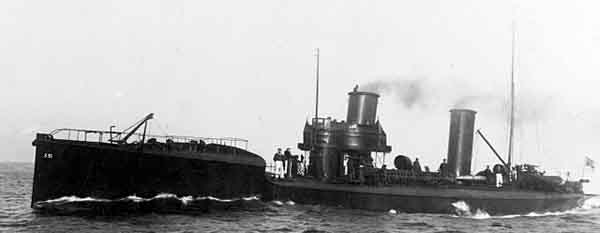
S95, of the S90 class.
Wartime German Torpedo Boats

SMS S68, A-III type
Therefore, no strictly speaking “torpedo boats” was built after 1894, and until… 1915. When it appeared these small, cheap, short range boats still could be very useful when deployed close to the enemy, from the occupied Belgian coast in particular. Zeebruge became a nest of torpedo boats in 1917. They were less complex and faster than submarine, and crews faster to train. Four classes were designed, with a process which started in 1914 already, at first for coastal defence, as 1890s boats were now obsolescent.
To the twenty-five A5 boats built in 1915 succeeded larger A26 types (23 built), six of the A50 type, and an ambitious program for the A56 class, which at nearly 400 tonnes were more than thrice the displacement of the A1 three years prior, and reached the level of early destroyers such as the “division boats” of the 1890s. However their torpedo armament was reduced to a single tube, and mostly relied on their light artillery, short-range but accurate 88 mm guns. These were in effect, more fast gunboats than torpedo-boats. By comparison, the 1890s Division boats had three torpedo tubes and up to six Hotchkiss guns.
Armament and tactics
In the 1870s, the use of spar-torpedo vessels was reduced to a single possible use: Either against a stationary target, or a very slowly moving ones. They were built essentially to disrupt a blockade, with the recent American Confederate vessels and tactics in mind.
The first nine were essentially tugs, 24 to 33 tons, but a single 430 tonnes vessel was converted in 1876 for the sake of reaching better speeds.
The first proper torpedoboote, with torpedo-launching tubes, appeared in 1882. Production was limited, and just like other navies of the time, Italy, Japan, Austria-Hungary or Russia, Germany ordered vessels to British Yards, notably the specialist of the type, Thornycroft, assisted by White for this order. These vessels, ans those who followed in the 1885-95 period were all considered “first class”.
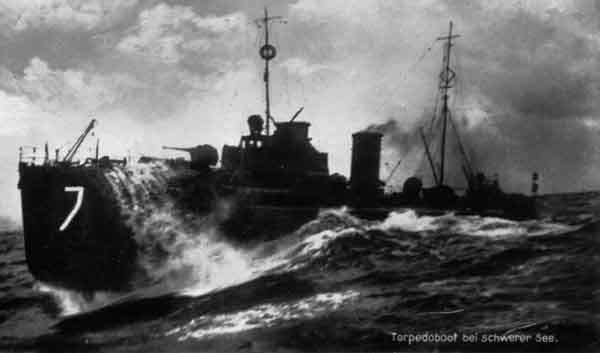
SMS G7 in action
Tactically, they diverged little from contemporary vessels. Organized into flotillas (without specialized leading vessel before the 1912 naval law), they were scrambled if a an enemy ship or squadron was spotted, rushed to the locations at 15-16 knots on average to spare their coal and engines, and then sped up to 18-22 knots for the attack, in formations that allowed them to close, fire and then retire in sequence.
Their limited gunnery was there only to combat similar vessels, and quick-firing. Early models had a single standard 37 mm Hotchkiss gun. Very fast, but very close range, it was here to cripple the enemy crew, having no protection on the turtle-deck of these frail vessels. These were essentially close defence weapons. The offensive weapon was of course the torpedo.
Torpedo Tubes
The explosive power of these early torpedoes was fairly limited: Until the 1890s, the standard model was 35 cm in diameter (14 in), but late vessels of the Schichau 1890s were armed with three 45 cm tubes (18 in). Division boats and early destroyers were armed the same, and stayed the same on WW1-era new torpedoboote, whereas the transition to 50 cm tubes took plane on destroyers from the 1909 naval law.
Guns
There were three types of guns in service with German torpedo boats:
-37 mm Hotchkiss: The French-American brand light semi-automatic guns were a huge international success and found their way in 1880s German torpedo boats. In general two or three were carried.
–50 mm Krupp: It was designed around 1905 and used fixed QF ammunition. In total it was 2.86 m (9 ft 5 in) long with an A-tube, rifled, steel construction with reinforcing hoops from the trunnions to the breech. It used the semi-automatic Krupp horizontal sliding-block breech.
-88 mm Krupp: Two models were used, the 30 and 35 calibers. The 1892 8.8 cm SK L/30 gun was a 2.64 meters, 644 kg (1,420 lb) gun fitted with the Wedge type Krupp horizontal sliding block, widely used from U-Boats to battleships.
The L/35 variant was introduced in 1904 and measured 3.08 m (10 ft 1 in). It was used notably on the S90 class TBs.
Prewar torpedo vessels (no longer active in 1914)
German Spar-Torpedo Vessels (1872-75)
All this time, the torpedo was used as the classic deterrent, more than mines, that were not developed as far as in other navies. An Austrian invention, the torpedo was imported and tested right after its 1860s equivalent, the “spar torpedo”. A crude explosive at the business end of a long spar, hence the name: A naval explosive was named a ‘torpedo’ back then.
In 1875, the Imperial Navy had 6 of these vessels to protect its harbors, trained to be used at night against blockading ships, such as the French Navy during the last war. In total, six were built in different yards until 1874, and in 1875 a large one converted. Interestingly enough, the very early 1s class V to XI torpedo boats built by Weser Yards in 1882 could alternatively carry a spar torpedo.
Devrient serie 1871
Three 33 tonnes, 20.3 x 3.3 x 1.9m small steam launched. They had a simple loco engines producing 250 ihp, enough for 8 knots. Numbered I-III like the following series. In 1875 the experiment was stopped and they were reclassified as minelayers (n°4-6). In 1881 they became auxiliary TBs, fitted with a single 381 mm bow TT and again numbered I-III. They were discarded in 1885 for good.
Waltjen serie 1871
Three 24 tonnes, 14.6 x 3.22 x 1.8 m vessels, 60 ihp and 7 knots. Small versions of the first, minelayers N°1-3 in 1875, discarded 1881.
Vulcan serie 1872
Three paddle wheel tugs from the same yard, converted as spar torpedo vessels. They were Notus (I), 303 tonnes, Zephir and Rival, 129 tonnes. Rival tested a water pump jet for a time. She was the only one retained for experimental purposes, while the two others were converted back as tugs quickly, while Rival was minelayer N°4 until 1884, and a tug again.
SMS Ulan (Möller e Holberg 1875)
This large tug was at first torpedo steamer n°IV, she displaced 431 tonnes, with dimensions 36.38 x 8 x 437 m. She had a 782 ihp steam engine, enough to reach 12 knots and a crew of 41 officers and sailors. She had two funnels in tandem, and was rebuilt soon after launch in 1876 to carry a 381 mm bow TT and three 37 mm Hotchkiss revolving cannons. Use for research for the Navy, she became a torpedo school tender and then a barge in 1909, seeing WW1. She was sold in 1919, possibly used as a tug again and BU in 1926.
The prewar series: First class TBs (1882-98)
The first classes were rather experimental, with fourteen homogeneous series and eleven prototypes, plus a serie from Thornycroft until 1890. They were led by nine “Divisionsboote” which were flotilla leaders in practice. Here is the list by yards for simplification according to Conway’s.
Weser series (14 boats)
-N°V-XI serie (1882): 7 boats, the oldest Torpedo Boats built as such in the German Navy.
They displaced 55 tons, measured 31.5 x 3.93 x 2.05 m, had a single shaft compound steam engine rathed for 590 ihp, allowing them to reach 19.5 knots. They were armed with two 350 mm TTs located in the bow, plus two reloads and a single Hotchkiss gun. They were originally named Schutze, Flink, Sharf, Tapfer, Kühn, Wörwarts, and Sicher, and later roman numerals. They were well armed but not satisfactory and were retired from service in 1891 as TBs, reclassed in other duties, no longer listed in 1914.
Jäger (1883) Torpedo Gunboat: Single experimental vessel. Much too small to be classed as a cruiser, she displaced 183 tonnes.
Dimensions: 34.8 x 5.58 x 2.6 m, single shaft compound steam engine rated for 550 ihp, 15 knots. She was armed with two 350 mm TTs and a single Hotchkiss gun.
originally she was to carry a 87 mm gun fore ad aft as a standard gunboat, but a pair of TTs were added at the bow. She was used for research and discarded in 1889, used in other roles and BU in 1900.
W1 class (1884): Six boats displacing 90 tonnes, 34.91 x 3.92 x 2.38 m in dimensions, propelled by a single shaft compound steam engine rated for 910 ihp, and could reach 19.5 knots. Armament was two 35 cm bow TTs, two reloads, and two Hotchkiss guns. Numbered at first XII-XVII. Information is scarce about these. No longer active in 1914. It seems Weser boats were not a pleasant experience for the German Navy despite their speed. The admiralty in parrallel already ordered boats in 1883 to Thornycroft and many other yards before adopting Schichau’s designs.
Vulcan series (10 boats)
Ten 1st class TBs at first numbered XVII-XXVIII, then V1-V10, built in 1884. Rather small, they displaced 68 tonnes, measured 32.91 x 3.92 x 2.38 m. They were powered by a triple expansion steam engine rated to 590 ihp, providing them with 17-3/4 knots. Armament was standardized, like the other designs contracted: Two bow TTS, two reloads, two Hotchkiss guns.
Thornycroft/White series (4 boats)
The first serie was ordered to J. Thornycroft Co. a standard 63 ft second class boat called Th2. The remainder three were White’s 2nd class wooden boats. Very small, these were “child TBs”, designed to be carried by a mothership (which was never developed). They were too small for effective service in rough seas.
Prototypes (1884-89)
-Thornycroft Th1: A 80 tonnes boat ordered, armed with two 350 mm TTs with spares, and two 37 mm Hothkiss guns. Fate unknown.
-Yarrow Y: A 82 tonnes, 36.35 m long boat, 600 ihp and 18 knots.
-Germaniawerft G: 85 tonnes, 36.70 m, 722 ihp, 18 knots
1889 test serie:
-Wilhelmshaven A: 104 tonnes, 37.92 m, 950 ihp and 19 knots.
-Kiel K: 100 tonnes, 37.58 m, 996 ihp and 18 knots.
-Dantzig A: 87 tonnes, 34.63 m, 590 ihp, 16 knots.
The Wilhelmshaven boat was probably the most interesting. The largest and fastest of the lot, she was armed with a single bow tube and two swiveling tubes plus spares and experimentally made of diagonal Mahogany planking on steel frames. This was not a happy marriage however and she was broken up in 1894. The fate of the others is unknown, they were probably retired after serving their purposes in the 1890s.
Schichau series (90 boats)

S7, of the S7-23 Schichau serie appearance (1884), author’s illustration
1st serie S1-65 (65 boats)
S1-S6 group: Built 1884-85, these first class TBs displaced 97 tonnes and measured 37.72 m x 4.82 x 2.23m. Single shaft TE engine, 870 ihp and 19 knots. They were numbered at first XXVIII to XXXIII. They defined the standard armament of two 350 mm TTs in the bow, two spare, two Hotchkiss guns. Reliable, fast and seaworthy, they seduced the admiralty in sea trials, which ordered another serie the next year in 1885 and subsequently all the next series would come from this yard.
S7-23 group: 1885 serie of 17 boats. 96 tonnes, 37.74 x 4.92 x 2.2 m, 1 shaft TE 830 ihp and 20-1/4 knots.
S24-S31 group: 1886 serie of 9 boats. 101 tonnes, 39.12 m x 4.8 x 2.34 m, single shaft TE 840 ihp and 19 knots.
S32: Single prototypes, 117 tonnes, 39.12 m long, 900 ihp and 19-3/4 knots
S33-41 group: Nine 1887 111 tonnes boats, 39.88 m long, 1100 ihp for 22 knots
S42: Prototype 1889 boat, 151 tonnes, 44.2 x 5 x 2.6 m, 1420 ihp, 22 knots.
S43-57 group: A repeat of the prototype but more powerful at 1570 ihp for 21-1/2 knots and with a 2.7 m draught instead of 2.6 m. 15 boats built 1889-1890.
S58-65 Group: Slightly longer serie (44.31 m but a return to the prototype’s draught) of 10 boats, built 1891-92. Less powerful at 1232 ihp for 20 knots.
All the boats in the S7-S65 group were armed with 3-350mm TT (1 spare torpedo) and 2 Hotchkiss guns. The complement was 16 (S7-S31) or 20 (S32-S65). All adhered to Schichau’s standard torpedo boat form, with the maximum breadth of hull well aft, producing a plan that resembled a pear shape. From 1893 a single 50mm gun replaced the Hotchkiss guns. Some of the earliest boats were discarded 1900-1910, becoming target boats or tenders, or just being broken up, but the majority were rebuilt and reboilered.
In 1910 the survivors had their designations changed from S to T, to clear the S numbers for new destroyers. During the war they were used as minesweepers. Pre-war losses were S12, in a collision at the mouth of the Elbe on 13.3.1908; T21, in a collision with her sister T38 on 16.8.1911; S26, which foundered in a storm at the mouth of the Elbe; S32, which was lost on 17.8.1910 in a collision with S76 in the Baltic; S41, which sank in a storm on 28.8.1895; S42, sunk in a collision in 1902
but raised and put back into service; and S48, lost in a collision in the Jade on 11.4.1896.
The following boats were lost during the war from various causes: T25, T43, T46, T47, T50, T51, T52, T54, T56, T57, T58, T64 and T65. This loss rate indicates the use the German Navy was still getting out of these sturdy boats. The survivors were all disposed of in the years immediately following the war.
2nd serie S66-89 (23 boats)
The S66-S87 series boats in general were all armed with 3-450mm TT (1 spare torpedo) and 1-50mm gun. Complements varied from 22 to 29. These vessels continued the same process of steady improvement of the basic design begun by their predecessors. Most were rebuilt and reboilered in the opening years of the new century.
S76 was lost in a collision in 1910, and S85 was stranded in 1898, but both were salved and returned to service. In September 1914 all were redesignated with the letter T beginning their numbers, and were used during the war as minesweepers and as tenders to instructional vessels. S66, S67, S68 and S78 were lost during the course of the war, the survivors being sold for breaking up between 1920 and 1921.
S66 1892 Prototype:
169 tonnes, 47.94 x 5.42 2.74 m (157ft 5in, 17ft 10in, 8ft 11in). 1 shaft TE 1610 ihp 22 knots.
S67-73 serie:
163 tonnes, same but 2.58 m draught, 1600 ihp and 21-3/4 knots. Seven built, launched 1892-94.
S74 prototype:
183 tonnes, 50 x 5.5 x 2.8m (16ft 10in, 18ft 7in, 9ft 2in). 1 shaft TE 2500 ihp 23-1/2 knots
S75-81 serie:
177 tonnes, 49 x 5.3 x 2.85m (160ft 11in, 17fr 5in, 9ft 4in), 1 shaft TE 1744 ihp 22-1/2 knots, seven built, launched 1897-96.
S82-87 serie:
Displacement: 167t, Dimensions: 158ft 3in x 16ft 9in x 8ft 5in (48.2 x 5.1 x 2.57m), 1-shaft TE, 2140ihp, 25 kts. Six built 1897-98.
G88-89 serie (Germaniawerft): Copies of the previous serie launched in parallel by the admiralty to bolster the numbers and constitute more squadrons.
174 tonnes, 48.7 x 5.04 x 2.81 m (159ft 11in, 16ft 7in, 7ft 2in), 1 shaft TE 2468 ihp 26 knots.
Prewar Divisionsboot (1886-94)
These ‘division boats’, or flotilla leaders, were basically larger versions of the torpedo boats they were intended to lead, with a similar armament and speed, but of a larger size in order to accommodate the extra staff needed. The most interesting design was the last, D9, which had the beginnings of the ‘trawler bow’, a raised forecastle which did not extend back as far as the bridge.
DI-D6 were armed with 3-350mm TT (1 spare torpedo) and 6 Hotchkiss guns; D7-D8 had 3-450mm TT (1 spare torpedo) and 6 Hotchkiss guns; and D9 was fitted with 3-450mm TT and 3-50mm Hotchkiss. Complement was 46, except D9 52. All were rebuilt and reboilered in the first decade of the new century. By 1893, 3-50mm guns had replaced the Hotchkiss revolving cannon.
D1 and D2 were converted to yachts for the Baltic and North Sea stations respectively, being named Carmen (1905) and Alice Roosevelt (1902). They were converted back for more warlike duties in 1914, and with the others were used for coastal defence patrols or training tasks, being finally discarded in 1920-21.
D1-D2 (1886):
295 tonnes, 56.05 x 6.6 x 3.4 m, 1 shaft TE 2020 ihp 20-1/2 knots
D3-D4 (1887):
295 tonnes, 57.64 x 6.8 x 3.23 m, 1 shaft TE 2200 ihp 20-1/2 knots
D5-D6 (1888):
400 tonnes, 59.58 x 6.8 x 3.5 m, 1 shaft TE 3200 ihp 22-1/2 knots
D7-D8 (1890):
404 tonnes, 59.72 x 7.4 x 3.4 m, 1 shaft TE 3600 ihp 22-1/2 knots
D9 (1894):
462 tonnes, 63 x 7.7 x 3.73 m, 1 shaft TE 4200 ihp 23-1/2 knots
Großes Torpedoboote series (1897-1902)
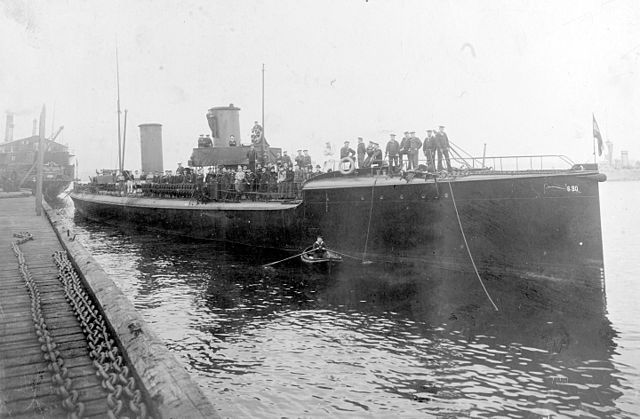

Author’s rendition of the Germaniawerft’s G108 class
D10 Thornycroft prototype (1896)
A copy of the ’30-knotters’, but with German armament of five 50 mm guns, three 450 mm TTs. The bow TT was later retired and unseaworthy. She srved in coastal defense and training and was broken up in 1922. Complement 47.
365 tonnes, 66.1 x 5.95 x 2.35 m, 2-shaft TE, 5780 ihp, 27-1/2 knots.
S90-S101 Schichau (1898-1901)
A coherent class of 12 boats (two squadrons) which set the stage for subsequent classes, generally divided in batches of six with gradual improvements until 1903.
388 tonnes, 63 x 7 x 2.23 m (206ft 10in x 22ft 11in x 9ft 4in), 2 shafts TE, 3900 ihp for 26-1/2 knots
S103-S107 Schichau (1900-1902)
Larger, faster and more powerful batch of six boats.
400 tonnes, 63 x 7 x 2.23 m (207ft 6in x 22ft 11in x 8ft 20in), 2 shaft TE, 5900 ihp 27-1/2 knots
G108-S113 Germaniawerft (1900-1902)
Second batch (6 boats) of the same basic design interpreted by Germaniawerft yard (hence the “G”), larger and faster.
433 tonnes, 65.8 x 6.7 x 2.87 m (216fft 1in x 21ft 11in x 9ft 5in), 2 shafts TE, 6000 ihp, 29 knots
S114-S199 Schichau (1902-1903)
Next year batch of six boats, slightly smaller and slower than Germaniawert boats.
408 tonnes, 63.2 x 7 x 2.69 m, 2 shafts TE 5900 ihp, 28 knots
S120-S124 Schichau (1903-1904)
Larger boats but batch of five boats (a 1904 prototype was supposed to added to the list).
461 tonnes, 64.7 x 7 x 2.63 m, 2 shafts TE, 6400 ihp for 27-1/2 knots
S125 Schichau prototype (1904)
Displacement: 447 tonnes, dimensions as the following serie, 6600 ihp and 27-1/2 knots, test boat for Parsons turbines.
S126-S131 Schichau (1904-1905)
Last batch of the early serie of Großes Torpedobootes. The largest and fastest of them all, but still with the same beam, seven meters (22ft 11in).
474 tonnes, 64.7 x 7 x 2.76 m, 2 shafts TE 6490 ihp, 28 knots.
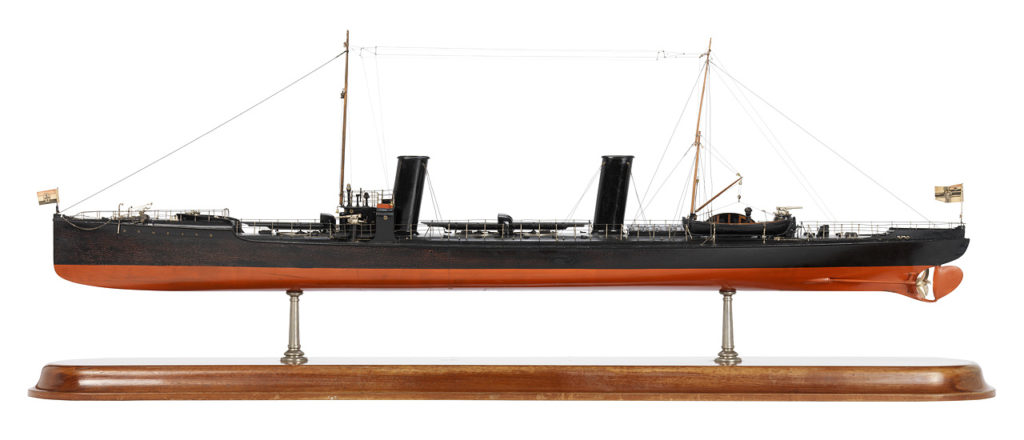
S90 at the national museum Greenwhich
S90-S107, G108-G113 and S114-S131 were all armed with three 450mm TT and three 50mm guns. The complement varied from 57 to 61. Apart from the experimental turbine S125 (another was building at the end of the period), these units, classed as large torpedo boats but, despite their lighter guns, really the equivalent of contemporary foreign destroyers, show a large degree of homogeneity.
They all shared the ‘trade mark’ of the torpedo tube placed before the bridge in a well deck between the raised forecastle and the charthouse. All had two funnels. In fact this design was a combination of the best features of the D9 and the D10, of the German torpedo boat traditional design, and of the British destroyers. The result was a sturdy and seaworthy vessel, not as fast as
foreign boats, but probably more useful than most. In 1914 they had been all re-classed as torpedo boats, and therefore are treated here rather than in the destroyer section.
Losses in action:
-S97 was converted before entering service to be the tender to the Imperial yacht Hohenzollern and was renamed Sleipnir. She was reconverted to a fighting ship when war broke out, and with all her sisters was reclassed as a T-boat in September 1914. Several of these boats were rearmed, wholly or partly, with 88mm guns.
-S90 was deliberately run ashore during the siege of Tsingtao in 1914.
-T116 was torpedoed and sunk by the British submarine E9 on 6.10.1914.
-T115, T117, TI18 and TI19 sank on 17.10.1914 British destroyers and the cruiser HMS Undaunted
-T100 lost in a collision in 1915
-T122 mined in 1918
-T123 mined in 1916
-T124 sank in 1914 in a collision
-T129 lost in 1915 (unknown causes).
-T126 lost in 1905, raised and repaired, served in WW2 but disposed of in the early 1920s.
The Imperial Navy had been acutely aware that its larger and more seaworthy vessels could at least dominate foreign navy torpedo boats but the introduction the torpedo boat destroyer in UK ruied this game and past 1895 force the transition towards a larger boat. Many technical and tactical considerations were taken in but enlarged versions of torpedo boats were preferred. The increase in the size was the main factor, which guaranteed better seaworthiness, sturdiness, better endurance, large accomodation of engines, and therefore more power and speed. This forced also a clear departure from the previous doctrine of single-shaft drive. Also, a single officer was no longer sufficient in command. Displacement more than doubled, top speed reached 27 to 28 knots in the best cases.
However compared to British standards, their armament was slightly weaker (in caliber), but with the benefit of one more torpedo tube. They were anyway superior to the French torpedo boat destroyers of the era however.
S90, the fighting German torpedo boat in China
To strengthen German forces off the Chinese coast (boxer revolt), the Imperial Navy sent three of these modern large torpedo boats to East Asia. By July 26, 1900 they departed with a support ship, what was called the East Asian Expeditionary Force. It comprised the S90-S92. They reached Shanghai on October 6th and supported the East Asian cruiser squadron. They monitored and patrolled the Chinese coast and great rivers estuaries like the Yang Tse. After the situation in China settled down, S 91 and S 92 departed back home on 6 March 1902 with SMS Kaiserin Augusta.
However, S 90 was kept there alongside the former Chinese destroyer SMS Taku, a Schichau boat captured in 1900 and used as a security ship in Tsingtau naval base (now Qingdao). Both frequently patrolled the Yangtze River and coastal waters. In 1913, Taku ran aground in Kiautschou Bay while S 90 was largely worn off. Both should have been replaced when the war broke out in August 1914, but soon the base was besieged by the Japanese.
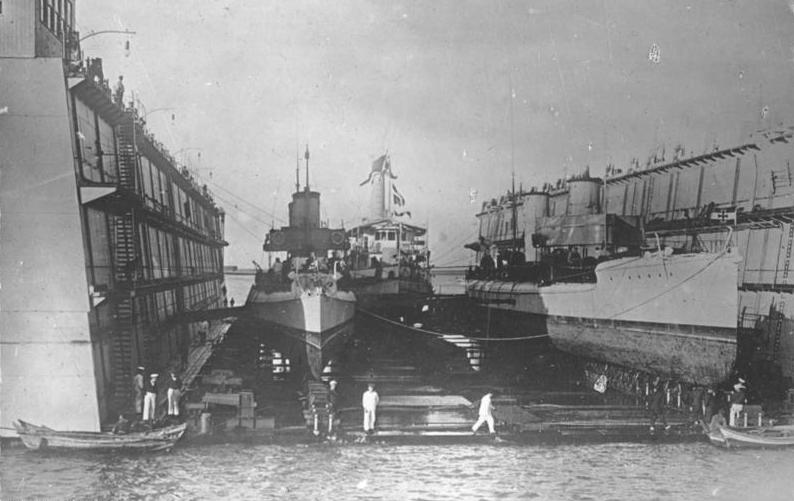
S90 and Taku in a drydock in Tingtau, China, 1914
S 90 assisted the gunboat SMS Iltis just before the siege, securing the departure ships leaving Tsingtau to join Graf Spee’s cruiser squadron in the Pacific, to serve as supply ships and reinforcements, such as SMS Emden, auxiliary cruisers Prince Eitel Friedrich and Cormoran. They closely monitored British China Station ships which themsekves kept an eye on Tsingtau. On the evening of August 22, 1914, the destroyer HMS Kennet spotted S90 guarding the minelayer SMS Lauting and attacked. S 90 duelled with Kennet, luring her away from the minelayer and down to battery range. A 105 mm land battery fired and scored a hit almost immediately on the British destroyer. SMS Jaguar then arrived and opened fire on Kennet also. The latter had 3 dead and 7 wounded.
Later during the siege, S90 would try to break through the blockade and evade picket ships of the Allied armada. One such sortie occurred on October 17, 1914, duing the night. She managed to close on old cruiser IJN Takachiho and fire her torpedoes. The cruiser sank, claiming 271. It became the largest naval loss of Japan during the great war.
Due to the lack of fuel however, S90 had nowhere to go and the commander, Lieutenant Colonel Paul Brunner, decided not to scuttle his boat but rather take refuge in a nearby Chinese harbour and he and his crew went into internment for the remainder of the war.
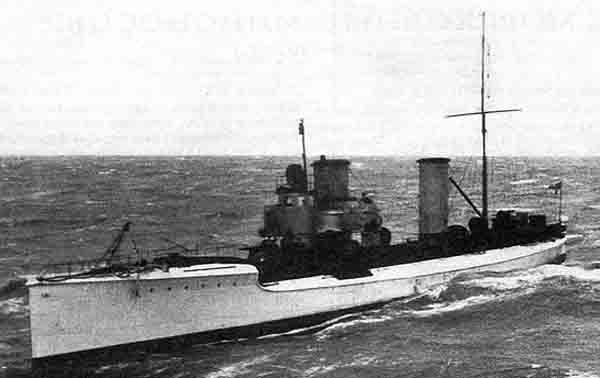
S90 underway in Asia – Notice the colonial white hull
Wartime Küstentorpedoboote (A series, 1915-1918)
These coastal torpedo boat classes A-I to A-III, or simply “A-boat” were wartime vessel specially designed for use in Flanders, and also used as a fast minelayers and escort ships.
Vulcan Hamburg built boats A 1 to A 25, A 56 to A 67 and A 80 to A 91 and subcontracted the Howaldtswerke in Kiel for boats A 83 to A 85. A26 to A55, A68 to A79 and A92 to A95 were built by the Schichau shipyard in Elbing.
The last serie was closing to a light destroyer. They were designed by the Reichsmarineamt to rush from the Flanders coast and attack any opportunity targets in the channel and north sea. The “A” was to clearly separate them from V, T and S designs. The naval books of the time denominated them Küstentorpedoboote (“coastal torpedo boats”) to mark their difference with the high seas and older regular models.
Six groups in total were built although by practicality, and as noted in Conways, only four series were clearly different (informally A-I to A-IV), with each time a clear upgrade in size, tonnage, speed and armament, from 109 tons to 335 tons. They all but the A-I types shared a raised forecastle and a shallow draught. They also carried a single (first serie) or two standard older 45 cm (18 in) torpedo tubes, placed amidships, and light guns for close defence;
A-I types (1915)

A-I serie appearance, author’s illustration
The serie comprised the A1 to A25. The 1914 design was built by Vulcan AG of Hamburg. This was subcontracted to other yards. They were commissioned from January 1915 and sent in modules and parts by rail to be assembled at Hoboken. These were frail and small, with poor seaworthiness, but saw heavy actions from the start in the Chanel, suffering heavy losses.
Wartime losses: A2 & A6 were sunk by British destroyers (1 May 1915) at the Battle off Noordhinder Bank, A3 lost in 1915, A15 by French destroyers on 23 August 1915, A13 was bombed in dock in 1917, A10 was sunk by mines in 1918, A7 and A19 sunk by British and French destroyers on 21 March 1918.
After the war: A1, A18 and A21–A25 surrendered and were stricken between 1921-1922, A11 and A17 sunk during the Kapp Putsch. A4, A5, A8, A9, A12, A14, A16 and A20 were war reparations to Belgium, but the small navy could not manage to maintain them. They were sold and scrapped in 1927. A12 was the only survivor, scrapped in 1948.

A2, of the A-I series
Specifications
Displacement: 109 t (107 long tons)
Dimensions: 41 m x 4.6 m x 1.52 m
Powerplant: Coal-fired, 1 shaft TE steam engine, 1,200 ihp (895 kW)
Speed: 20 knots (37 km/h; 23 mph), Range: 900 nm (1,700 km; 1,000 mi) @12.5 knots
Crew: 28
Armament: 1 × 50 mm SK L/40/52 mm SK L/55, 2 × 45 cm (18 in) TT, 4 mines
A-II types (1916)
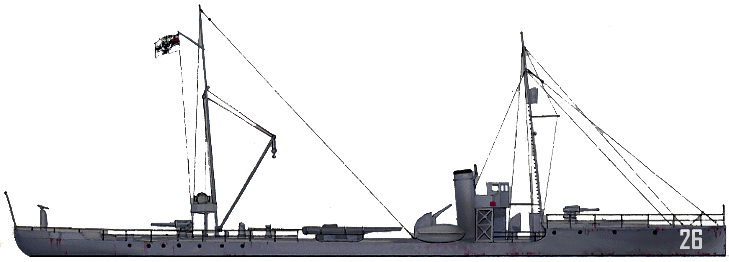
A26, of the A-II serie, author’s illustration
The serie comprised the A25-A55. They were built in Schichau and doubled as minesweepers. Called also the 1915 design. Larger, with better seaworthiness, 23 of these Type II were delivered and commissioned from May 1916. They were also carried by dismounted sections by rail and assembled at Hoboken (Antwerp). They had their fair share of heavy action.
Losses:
A32, sunk during the “Operation Albion” in 1917 (she was raised, repaired, Sulev in the Estonian Navy), and A50 was mined in 1917. A51 was scuttled in 1918. A26–A29, A31, A33–A39, A41, A44–A46, A48, A49, and A52–A55 surrendered (stricken 1920-1921). A30, A40, A42 and A47 were scuttled in 1927, and A43 was in service in WW2, scrapped in 1943. Another model commissioned, called Model 1915 A-II, they were a variant of the first A50-55. Slightly larger at 229/252 tonnes in displacement, 5.6 m wide and 2.2 m in draught. One was transferred to Pola and served as a tender for the German Submarine fotilla in the Adriatic. A50 was mined and A51 scuttled in 1918. The others became war reparations to UK, quickly BU.
Specifications
Displacement: 227–229 t (223–225 long tons)
Dimensions: 49 m x 5.32–5.62 m x 2.34 m
Powerplant: Oil-fired, 1 shaft geared turbine steam engine, 3,250 hp (2,424 kW)
Speed: 25 knots (46 km/h; 29 mph), Range: 690 nm (1,280 km; 790 mi)
Complement: 29
Armament: 2 × 8.8 cm, 1 × 450 mm TT, mines
A-III types (1917)
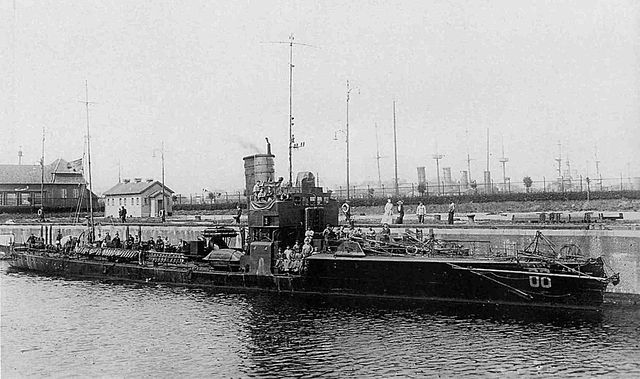
SMS A68
The last wartime serie, called model 1916. They were commissioned from late 1917 to the end of the war. Much larger, they were built by Vulcan in Stettin, Schichau in Elbing, and Howaldtswerke in Kiel and they varied in details. The Schichau boats had turbines, Vulcan and Kiel boats AEG Vulcan direct drive TE. Normal speed was 26 knots but some reached 28 knots in service. 37 were commissioned but A96-A113 were never completed at the end of the war. They were also designed to be carried by dismounted sections by rail and one was sent to Pola. After the war four boats were ceded to Poland.
A59, A60 and A61 caused severe damage to HMS Terror on 19 October 1917. The only one never completed, A67, was scrapped in 1921.
The serie comprised the A56 to A79.
Losses: A60 hit mines and sank in 1917, A56, 57 and A58, A71, A73, A77 and A79 hit mines and 1918. A69, A70, A74–A76, and A78 were stricken in 1920. War reparations:
-A61, A62: to Britain (scrapped in 1923).
-A63, A66 to France (scrapped in 1923).
-A64, A68 to Poland, in service WW2, scuttled off Danzig, Sept. 1939.
-A65 to Brazil, scuttled in Britain.
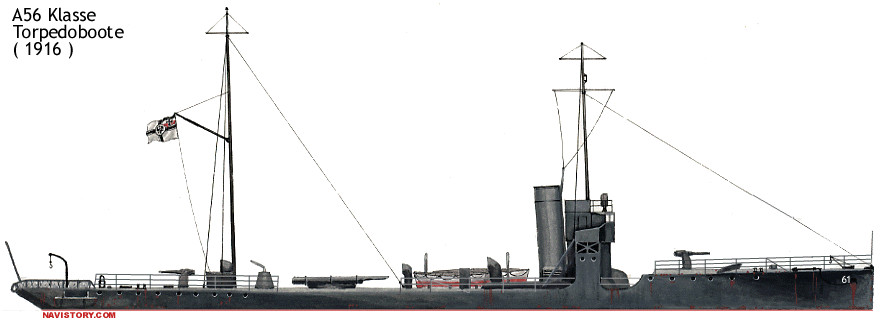
A61, of the A-III serie, author’s illustration
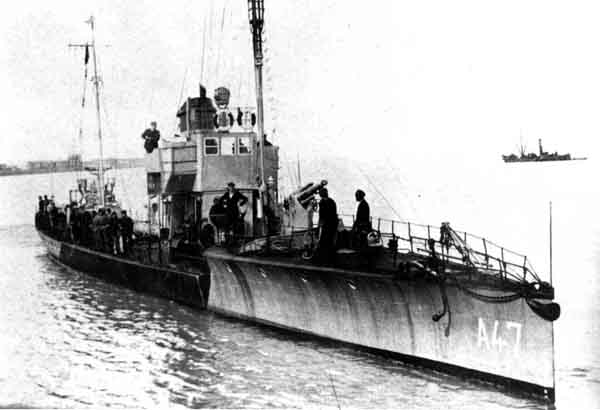
A47 of the A-III serie
Specifications
Displacement: 330–335 t (325–330 long tons)
Dimensions: 59.3–60.12 m x 6.42 m x 2.21–2.34 m
Powerplant: 2 shafts, Geared turbine SE (oil), 6,000 shp (4,474 kW)
Speed: 28 knots (52 km/h; 32 mph), Range 800 nm (1,500 km; 920 mi)
Crew: 50
Armament: 2 × 8.8 cm, 1 × 450 mm (18 in) TTs
A-IV types (1918)
Serie A80-A91. Only a small part of the vessels entered service. None was lost, A82 was scuttled at Fiume in 1918, A81, A86–A91 were stricken in 1920 and A83–A85 were scrapped incomplete, 1919. A80 served in the interwar ans was scrapped in 1938.
Specifications
Displacement: 330 t (325 long tons)
Displacement: 60.2 m x 6.41 m x 2.11 m
Powerplant: 2 shafts geared turbine SE, oil-fired 5,700 shp
Top Speed: 26 knots (48 km/h; 30 mph), Range 800 nm (1,500 km; 920 mi)
Complement: 50
Armament: 2 × 8.8 cm, 1 × 450 mm TT
The last serie, A92–A113.
None of this late serie was in active service. A92–A95 were stricken in 1920, and the incomplete A96–A113 were scrapped on the stocks in 1919.
They were slightly heavier, at 330–335 t (325–330 long tons). Same lenght but slightly wider, higher draft (6.42 m and 2.12 m). Perhaps due to better hull shape it seems top speed was half a knot faster for the same powerplant, the two shafts driving 1.6 m (5 ft 3 in) propellers. Armament and crews were the same.
V105 class (1915)
Four requisitioned boats: They were the Z1-Z4 ordered by the Netherlands at Vulcan, Stettin and taken over on 10 August 1914 by the German government while fitting out. They were launched from 26/8/1914 to 12/12/1914 and completed in January and March 1915 and completed later that year. They were classed as torpedo boats or hochseetorpedoboats depending on the sources. They looked like reduced, compact versions of standard destroyers, with two funnels and a forecastle.
Gunnery-wise, they differed considerably: V105 and 107 had two 88/42 TK L/45 C/14 guns, but V106 had 52/51 SK L/55 C/03 models and V108 two 88/27 TK L/30 C/08 models.
During the war, V107 hit a Russian mine on 8/5/1915 off Libava and was declared constructive loss and stricken. V106 was sold to Brazil in 1920 while V105 and 107 went to the Polish Navy as Mazur and Kaszub. They were in service in WW2 (see the Polish page)
Specifications
Displacement: 340t st, 421 FL
Dimensions: 62.6 oa (62.0 wl) x 6.22 x 2.54 m
Propulsion: 2 shafts AEG-Vulcan steam turbines, 4 Yarrow boilers 5,500 shp
Performances: Top speed 28 knots, range 1400 nm (17knots), coal 60 + oil 16 tonnes
Armament: 2 x 88 mm, 2 single 450 mm TT
Complement: 60
Read More
Conway’s all the worlds fighting ships 1860-1905 & 1906-1921
Google Book: German naval strategy until 1888
“V 43 in Dictionary of American Naval Fighting Ships”. US Navy. Ships History Branch.
“German WWI warships rediscovered in Portsmouth Harbour after lying forgotten for decades”. The Independent.
“S 132 in Dictionary of American Naval Fighting Ships”. US Navy. Ships History Branch.
Kontreadmiral a.D. Stoelzel, Ehrenrangliste der Kaiserlich Deutschen Marine 1914-18 (Thormannn and Goetsch, Berlin, 1930)
Walter Gladisch, Der Krieg zur See, 1914-18: Der krieg in der Nordsee v. 7, (Frankfurt, E.S. Mittler & Sohn, 1965)
Paul Köppen, Der Krieg zur See, 1914-18: Entworfen and Die Überwasserstreitkräfte und ihre Technik, (Berlin, E.S. Mittler & Sohn, 1930.)
Dodson, Aidan (2019). “Beyond the Kaiser: The IGN’s Destroyers and Torpedo Boats After 1918”. Osprey Publishing.
Erich Gröner, German Warships 1815–1945, Volume 1: Major Surface Vessels (London: Conway Maritime Press, 1990).
John C. Taylor, German Warships of World War I (London: Ian Allan Ltd., 1969). ISBN 0-71100-099-9
//en.wikipedia.org/wiki/German_ocean-going_torpedo_boats_and_destroyers_of_World_War_I
German TBs on german-navy.de – Michael Emmerich
http://www.warshipsww2.eu archives – German TBs on wayback machine
On navypedia by Ivan Goglin
//de.wikipedia.org/wiki/Liste_deutscher_Torpedoboote_(1871%E2%80%931919)
//en.wikipedia.org/wiki/Schichau-Werke
//en.wikipedia.org/wiki/8.8_cm_SK_L/30_naval_gun
Schichau boats CC Photos on wikimedia commons
Model Kits:
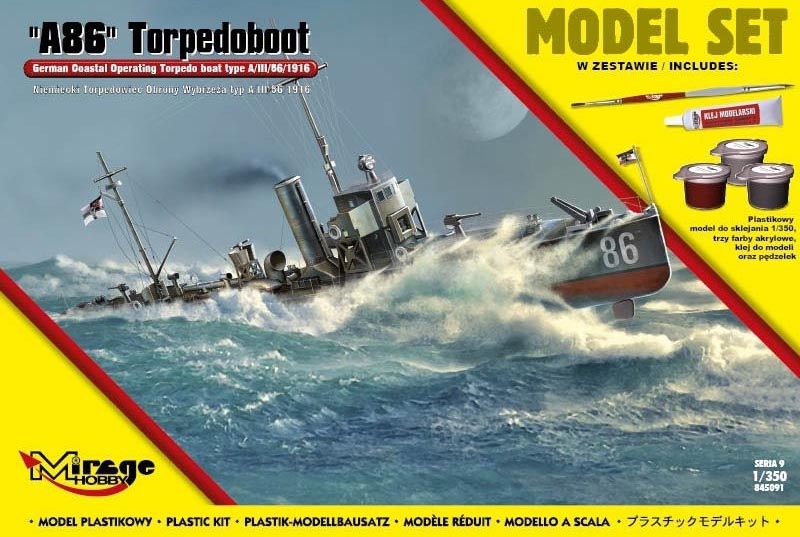
-The Mirage Hobby 1/350 A86 (A-III class TB). ORP Podhalanin Polish torpedo boat was made after the kit and won many prizes.
–An old NNT kit 1/700 of SMS A-80
https://en.wikipedia.org/wiki/A-class_torpedo_boat
https://www.naval-encyclopedia.com/ww1/images/ships/germany/
https://de.wikipedia.org/wiki/Liste_deutscher_Gro%C3%9Fer_Torpedoboote_(1898%E2%80%931919)
They are many S-Boat kits out there, but no WW1 German torpedo boat around, even the wartime A series but one, which is a shame.
Now if you are a 3D modeller and are interesting by doing one, i’ll be gladly selling it here.
WW1 Hochseetorpedoboote:
Mirage Hobby 1:400 German Torpedo Boat V 106
Flyhawk – 1/700 German Large Torpedo Boat G-39 1916
Kombrig S90, 1899 1/700
A paper model 1/200 of S108 by Digtal scale – Steenavy review

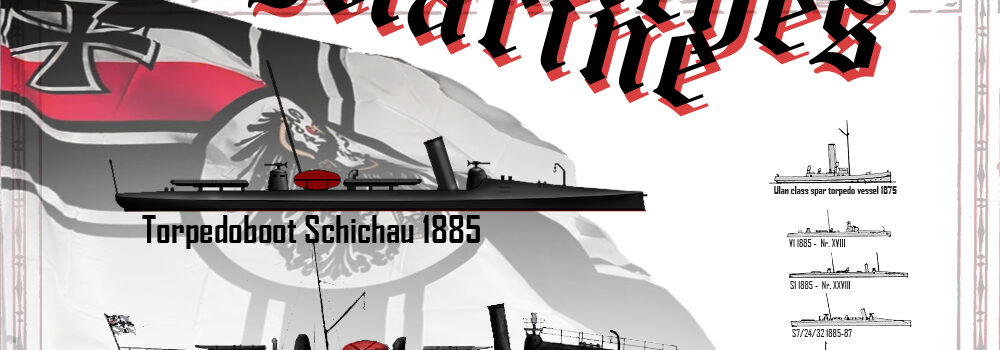

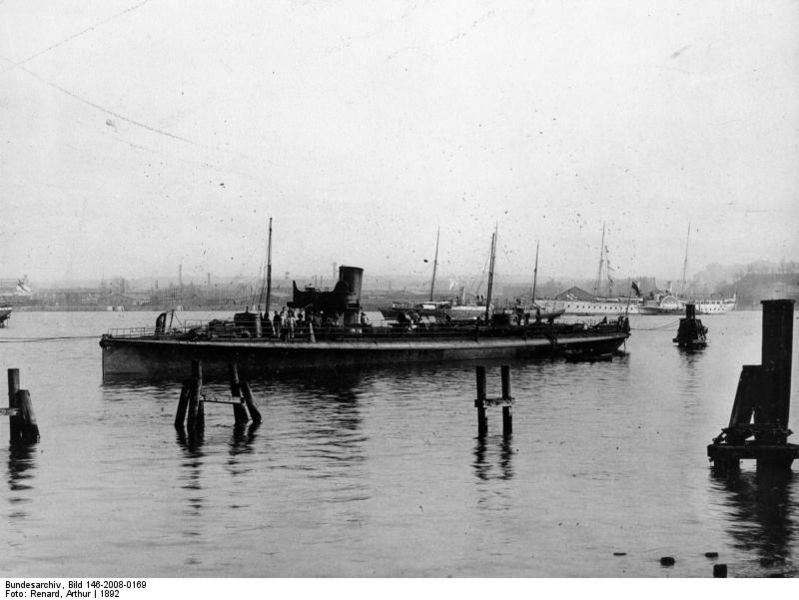
 Latest Facebook Entry -
Latest Facebook Entry -  X(Tweeter) Naval Encyclopedia's deck archive
X(Tweeter) Naval Encyclopedia's deck archive Instagram (@navalencyc)
Instagram (@navalencyc)





 French Navy
French Navy Royal Navy
Royal Navy Russian Navy
Russian Navy Armada Espanola
Armada Espanola Austrian Navy
Austrian Navy K.u.K. Kriegsmarine
K.u.K. Kriegsmarine Dansk Marine
Dansk Marine Nautiko Hellenon
Nautiko Hellenon Koninklije Marine 1870
Koninklije Marine 1870 Marinha do Brasil
Marinha do Brasil Osmanlı Donanması
Osmanlı Donanması Marina Do Peru
Marina Do Peru Marinha do Portugal
Marinha do Portugal Regia Marina 1870
Regia Marina 1870 Nihhon Kaigun 1870
Nihhon Kaigun 1870 Preußische Marine 1870
Preußische Marine 1870 Russkiy Flot 1870
Russkiy Flot 1870 Svenska marinen
Svenska marinen Søværnet
Søværnet Union Navy
Union Navy Confederate Navy
Confederate Navy Armada de Argentina
Armada de Argentina Imperial Chinese Navy
Imperial Chinese Navy Marinha do Portugal
Marinha do Portugal Mexico
Mexico Kaiserliche Marine
Kaiserliche Marine 1898 US Navy
1898 US Navy Sovietskiy Flot
Sovietskiy Flot Royal Canadian Navy
Royal Canadian Navy Royal Australian Navy
Royal Australian Navy RNZN Fleet
RNZN Fleet Chinese Navy 1937
Chinese Navy 1937 Kriegsmarine
Kriegsmarine Chilean Navy
Chilean Navy Danish Navy
Danish Navy Finnish Navy
Finnish Navy Hellenic Navy
Hellenic Navy Polish Navy
Polish Navy Romanian Navy
Romanian Navy Turkish Navy
Turkish Navy Royal Yugoslav Navy
Royal Yugoslav Navy Royal Thai Navy
Royal Thai Navy Minor Navies
Minor Navies Albania
Albania Austria
Austria Belgium
Belgium Columbia
Columbia Costa Rica
Costa Rica Cuba
Cuba Czechoslovakia
Czechoslovakia Dominican Republic
Dominican Republic Haiti
Haiti Hungary
Hungary Honduras
Honduras Estonia
Estonia Iceland
Iceland Eire
Eire Equador
Equador Iran
Iran Iraq
Iraq Latvia
Latvia Liberia
Liberia Lithuania
Lithuania Mandchukuo
Mandchukuo Morocco
Morocco Nicaragua
Nicaragua Persia
Persia San Salvador
San Salvador Sarawak
Sarawak Uruguay
Uruguay Venezuela
Venezuela Zanzibar
Zanzibar Warsaw Pact Navies
Warsaw Pact Navies Bulgaria
Bulgaria Hungary
Hungary

 Bundesmarine
Bundesmarine Dutch Navy
Dutch Navy Hellenic Navy
Hellenic Navy Marina Militare
Marina Militare Yugoslav Navy
Yugoslav Navy Chinese Navy
Chinese Navy Indian Navy
Indian Navy Indonesian Navy
Indonesian Navy JMSDF
JMSDF North Korean Navy
North Korean Navy Pakistani Navy
Pakistani Navy Philippines Navy
Philippines Navy ROKN
ROKN Rep. of Singapore Navy
Rep. of Singapore Navy Taiwanese Navy
Taiwanese Navy IDF Navy
IDF Navy Saudi Navy
Saudi Navy Royal New Zealand Navy
Royal New Zealand Navy Egyptian Navy
Egyptian Navy South African Navy
South African Navy






























 Ukrainian Navy
Ukrainian Navy dbodesign
dbodesign
Can you tell me about an old 1900 circa photo German Imperial Navy of the 50 seamen and 15 officers on board a speedboat, the numbers suggest it may be a squadron photo. The photo 16cm x 11cm is very clear the officers and seamen are Very smartly dressed, at the front centre is a lifebelt with ” 3 Sorpedoboots — Dulbflottille” written around it, the cap tally’s read ” Sorpedboot Tiger ” all the letters are in old gothic German so I may have miss read some of the letters.
The Boat looks about 30 feet wide it may have 2 funnels with an open metal crows nest with a searchlight and round radio aerial on the forward superstructure, there appears to be a deck gun then a breakwater ( which all of the crew are behind ) in front of the breakwater is a large steel wheel ( simular to a submarine deck hatch wheel )
If i stick to the “Torpedoboote Tiger” it’s tricky because none of the pre-WWI German TBs was supposed to be named that way, they all had numbers (which should appear on the hull BTW). Without the photo it’s difficult to pintpoint it.
However TBs with two funnels at circa 30 feets should be early 1890s Schichau models (they nearly all had one) to the exception of S42 (1889), the S43 and S56 classes. They are in the range and description.
Best !
Hi,
the Schichau Klasse Torpedoboot is not german, is austrian. I dived at the wrack of the TB26-Flamingo, one of them. Most beatiful boot I saw underwater.
I would say it is polish Now. It was created in Elbing, now Elbląg. But BTW nice story.
Hi there,
My name is Frank van der Linde and I am a biggg fan off your page. I have spend hours and hours looking into it to see if I can find my own vessel that i bought. About 30 years ago I bought this “as the story says” ww1 patrol vessel out of 1911. its a shame that i can’t put pictures on here otherwise i would but it’s about 19 m long and a beam of about 3,4m. I am complety rebuilding the vessel and only currently i found 2 numbers on the hull. It would be great if you could send me in the right direction so I could figure out what kind off vessel it is, where it was build and what it has done in ww1,
The numbers in the hull that i found are
Ah 518 N
A u 326 N
It’s just a shot in the dark and the start of my investigation but thought lets give it a go, Thanks for all the great work you do and wanted to let you know that it is highly appreciated, have a great day,
Frank
Hi Frank, many thanks !, You can contact me via [email protected]. Not sure i can help you on this though.